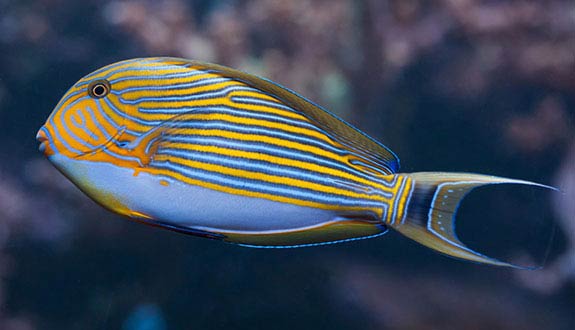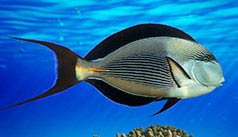

Alternative species (click on the thumbnail to see the card)
Names
Scientific name
Acanthurus lineatus
Acanthurus vittatus
Aspisurus lineatus
Chaetodon lineatus
Ctenodon lineatus
Harpurus lineatus
Hepatus lineatus
Rhombotides lineatus
Teuthis lineatus
Common name
Clown Tang
Lined surgeonfish
Striped surgeonfish
Blue banded surgeonfish
Clown surgeonfish
Striped surgeonfish
Blaustreifen-Doktorfisch (D)
Origin

Origin: Indian Ocean and South Pacific
Natural habitat: it lives in areas with strong current, near coral reefs, up to 15m (50 feet) deep
Dimorphism

Males grow larger than females
Group

Acanthuridae
Volume

1,000 L / 220 imp gal / 265 US gal
Parameters

T°: 24 to 30°C or 75 to 86°F
pH: 8.2 to 8.5
Density: 1021 to 1026
Difficulty

Hard
Size

28 cm (11")
Longevity

40 years
Living zone
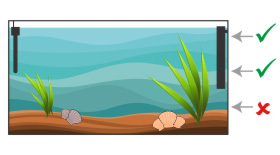
Middle and top
Individuals
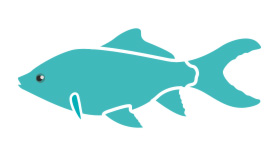
1
Food
How to feed the Clown Tang?
Food
How to feed the Clown Tang?
Like many Surgeons, this species is mainly herbivorous. Vegetable proteins therefore constitute the major part of its diet. Moreover, don't be surprised if your fish grazes on the algae of the scenery: it is a natural behavior!
For meals, distribute salad, spinach, broccoli, nori (previously boiled) or food in the form of granules or flakes for vegetarian fish. Supplement with a small meat portion in the form of artemia, tubifex, mysis, krill, nereis or mussel meat (live or frozen).
Behavior
What kind of behavior does the Clown Tang have?
Behavior
What kind of behavior does the Clown Tang have?
The Clown Tangis an excellent swimmer, fast and agile, and he loves it! He spends his day swimming and strolling around the scenery grazing on algae here and there. So he will need a lot of space.
It is a very territorial and warlike fish. However, its aggressive temperament decreases according to the space which it has. Thus, the bigger the aquarium is, the more it is quiet. In spite of everything, it is very nervous at times. He will then chase away all the occupants of the aquarium for a period of time without any apparent reason (territorial, breeding period...?), then calm comes back.
Cohabitation
Who can live with the Clown Tang?
Cohabitation
Who can live with the Clown Tang?
The cohabitation in aquarium of this species is always delicate. It is the big black point of its maintenance in captivity. Keep in mind that the bigger the aquarium is (at least 1,000/1,200 liters – 220/264 Imp Gal – 265/317 US Gal in community) the better the relations with the other occupants will be.
The Acanthurus lineatus is aggressive towards its congeners, fish with a similar coat, other surgeon fish, larger fish and newcomers. Peaks of aggression often occur during food distributions.
Only the presence of smaller fish seems to be tolerated, therefore it is recommended that the Striped Surgeon be the only large fish in the aquarium.
On the other hand, it is very respectful of corals.
Breeding
How to breed the Clown Tang?
Breeding
How to breed the Clown Tang?
Not known in aquarium.
The shape of juveniles is quite different from that of their parents. Indeed, their caudal fin is rather rounded, and becomes indented as they grow:
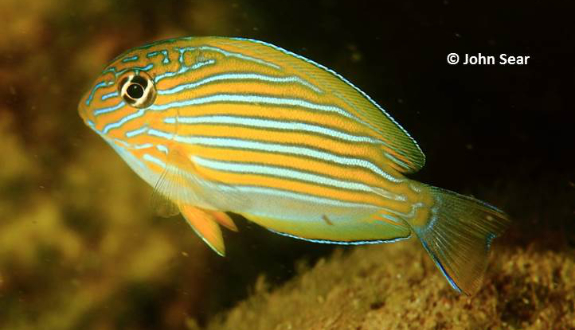
Its aquarium
Which aquarium for the Clown Tang?
Its aquarium
Which aquarium for the Clown Tang?
The Acanthurus lineatus is perfectly at ease in a reef aquarium. Indeed, the quality of the water (very clean and well oxygenated) and the decoration are to its taste. Moreover, it does not destroy the corals, quite the contrary! It grazes the filamentous green algae, preventing them from harming invertebrates. Compose your decor of stone and corals in the middle and high part (while leaving a vast space free for swimming), and install a layer of algae in the bottom of the aquarium: success guaranteed!
Given its active and scrappy side, maintenance of this species will only be done in large aquariums (at least 1,000 liters / 220 Imp Gal / 265 US Gal for a community).
Also install a strong current and powerful lighting (to encourage the growth of the algae it feeds on).
Good To know
Find all additional information!
Good To know
Find all additional information!
Its name of "surgeon fish" comes from the presence of scalpels are located on the tail in front of the caudal fin.
When you buy, make sure that the fish does not suffer from weight loss, especially if it is young: this type of profile is very difficult to recover and unfortunately most of these specimens will die quickly.
Like many Surgeons, acclimatization can be tricky. However, after this period, Acanthurus lineatus is rather robust and easy to maintain.
In the subfamily of Acanthurines (true Surgeon's Fish), there are about 55 species divided into 3 genera. The Acanthurus genus is the most important with 36 distinct species.
Yours photos!
Comments
Sort by:
Please login to post comments
